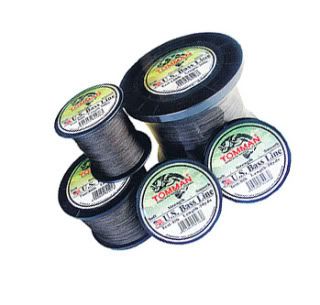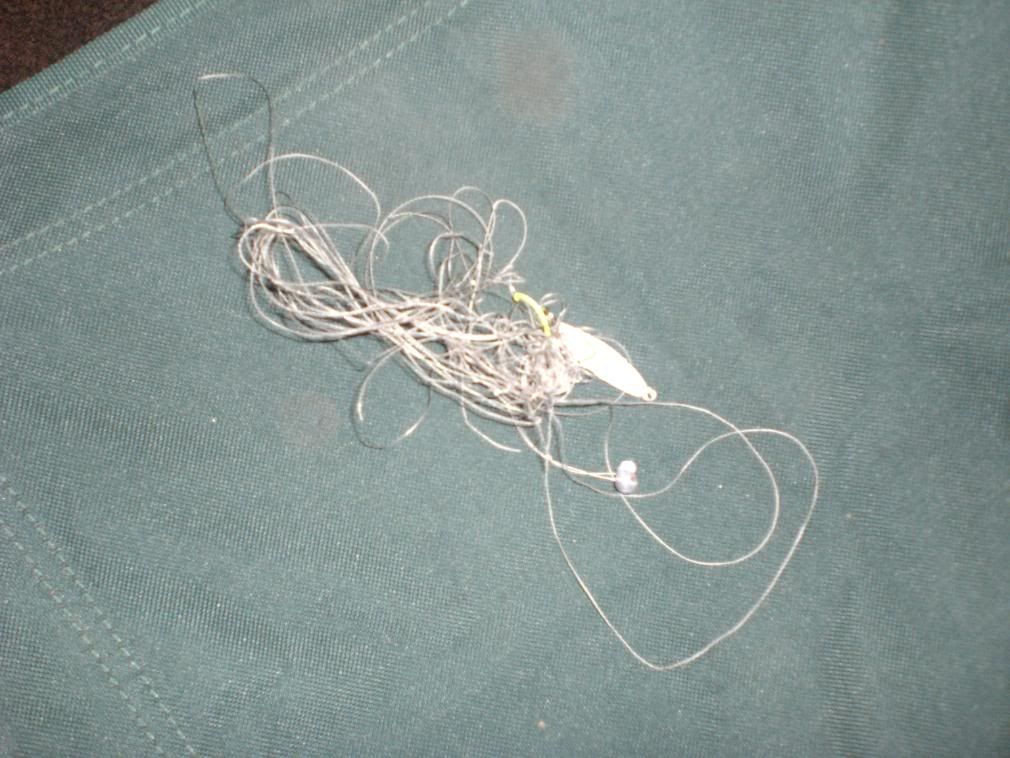Modern monofilament lines are a vast improvement on those of even a few years ago. Diameter has decreased and breaking strains increased. Some of the new fluorocarbon lines are now virtually invisible in water.
Monofilaments
Whatever main line you use, there is one rule that applies at all times -change your lines regularly. All mono lines deteriorate in time, especially if continually exposed to the sun, and you should renew your lines at least three times a season.
The three monofilament main lines recommended are Drennan Specimen Plus, Berkeley Trilene XT and Sufix Synergy. Specimen Plus is the all-round main line in all breaking strains, but when you require greater abrasion resistance, the Trilene or Sufbc lines are excellent.
All three lines are not ideal for hooklinks as they are a little springy. If you require a monofilament hooklink you need more limpness, and then you might want to switch to Drennan Float Fish or Sufix Ultra Supreme. Anglers who fish for smaller fish will find their low diameters helpful in creating delicate bait presentation. One of the best standard pre-stretched lines with ultra-low diameter is Drennan Double Strength. One of the problems with extra-low diameter pre-stretched lines is that they tend to be a little stiff. A good compromise, if you require a little pre-stretch but a line that is ultra limp, is extra-soft Trilene XL or Pro Micron.
An exciting development in recent years has been the advent of fluorocarbon lines, which have the same refractive index as water. In other words, they become invisible on immersion. These enable very subtle bait presentations to be made, and the Sufix Invisiline is highly recommended if you are using monofilament links over 4 lb (1.81 kg) breaking strain.
Other Hooklink Materials
For most carp and barbel fishing soft braided hooklinks are suitable.
Good braids are Drennan Carp Silk and Rod Hutchinson's The Edge. If you are fishing in woody snags, all braids can have a problem if the fibres are continually picked at by wood splinters, progressively weakening the material. Braids are also not ideal if fishing in heavy flows for chub and barbel, particularly upstream where the terminal tackle is constantly on the move, as they tangle very easily. In these situations, you may wish to revert to Drennan solid Dacron. Another alternative is a smoothly coated braid, of which there are many on the market.
Another specialized product from Rod Hutchinson is the Edge Plus, which is a braid with a fine lead core. Using several feet of this above the hooklink ensures that the main line is nailed to the bottom, thereby eliminating the problem of line bites. In barbel fishing, it also keeps the main line below drifting debris.
Super Braids
There is a growing use of ultra-low diameter, high-strength super braids. Many anglers are using these both as main lines and hooklinks, for the advantages of high strength-to-diameter ratio, zero stretch and good bait presentation. If you adopt this procedure, please be responsible. A 30 lb (13.6 kg) high-strength braid can be as fine as 7 lb (3.18 kg) mono, but a fish running into a snag could get tethered with no way of breaking free. These braids should really be reserved for hooklinks. This gives the advantage of enhanced bait presentation, but a main line break will still allow a hooked fish to escape.
There are two basic types of high-strength braid: round or flat section. However, some of the flat varieties are subject to sudden fracture if a wind knot develops. Some are also too stiff, although that does help to overcome the problem that occurs with all braids, that of tangling on the cast. The Sufix Herculine, available in breaking strains from 11 lb (5 kg) upwards, is recommended. This variety has a diameter roughly equivalent to 3 lb (1.36 kg) mono and makes a huge difference if you require fine presentation with a small hook for big powerful fish, such as feeder fishing for tench and barbel. The only problem with Herculine is that, because it is so limp, rigs must be as tangle proof as possible.
Trace Wires
It is a good idea to construct your own pike traces. Use 20 lb (9.07 kg) strand wire and simply twist the swivel and leading treble to the trace with at least a 1 in (2.5 cm) twist. A refinement is strand-coated wire, which is softer and limp to the touch. This is twisted in place in the same way and the plastic coating fused into a solid bond over a low flame. Whatever trace wire you use, make any pike trace at least 20 lb (9.07 kg) in strength and your traces at least 18 in (45 cm) long.
Monofilaments
Whatever main line you use, there is one rule that applies at all times -change your lines regularly. All mono lines deteriorate in time, especially if continually exposed to the sun, and you should renew your lines at least three times a season.
The three monofilament main lines recommended are Drennan Specimen Plus, Berkeley Trilene XT and Sufix Synergy. Specimen Plus is the all-round main line in all breaking strains, but when you require greater abrasion resistance, the Trilene or Sufbc lines are excellent.
All three lines are not ideal for hooklinks as they are a little springy. If you require a monofilament hooklink you need more limpness, and then you might want to switch to Drennan Float Fish or Sufix Ultra Supreme. Anglers who fish for smaller fish will find their low diameters helpful in creating delicate bait presentation. One of the best standard pre-stretched lines with ultra-low diameter is Drennan Double Strength. One of the problems with extra-low diameter pre-stretched lines is that they tend to be a little stiff. A good compromise, if you require a little pre-stretch but a line that is ultra limp, is extra-soft Trilene XL or Pro Micron.
An exciting development in recent years has been the advent of fluorocarbon lines, which have the same refractive index as water. In other words, they become invisible on immersion. These enable very subtle bait presentations to be made, and the Sufix Invisiline is highly recommended if you are using monofilament links over 4 lb (1.81 kg) breaking strain.
Other Hooklink Materials
For most carp and barbel fishing soft braided hooklinks are suitable.
Good braids are Drennan Carp Silk and Rod Hutchinson's The Edge. If you are fishing in woody snags, all braids can have a problem if the fibres are continually picked at by wood splinters, progressively weakening the material. Braids are also not ideal if fishing in heavy flows for chub and barbel, particularly upstream where the terminal tackle is constantly on the move, as they tangle very easily. In these situations, you may wish to revert to Drennan solid Dacron. Another alternative is a smoothly coated braid, of which there are many on the market.
Another specialized product from Rod Hutchinson is the Edge Plus, which is a braid with a fine lead core. Using several feet of this above the hooklink ensures that the main line is nailed to the bottom, thereby eliminating the problem of line bites. In barbel fishing, it also keeps the main line below drifting debris.
Super Braids
There is a growing use of ultra-low diameter, high-strength super braids. Many anglers are using these both as main lines and hooklinks, for the advantages of high strength-to-diameter ratio, zero stretch and good bait presentation. If you adopt this procedure, please be responsible. A 30 lb (13.6 kg) high-strength braid can be as fine as 7 lb (3.18 kg) mono, but a fish running into a snag could get tethered with no way of breaking free. These braids should really be reserved for hooklinks. This gives the advantage of enhanced bait presentation, but a main line break will still allow a hooked fish to escape.
There are two basic types of high-strength braid: round or flat section. However, some of the flat varieties are subject to sudden fracture if a wind knot develops. Some are also too stiff, although that does help to overcome the problem that occurs with all braids, that of tangling on the cast. The Sufix Herculine, available in breaking strains from 11 lb (5 kg) upwards, is recommended. This variety has a diameter roughly equivalent to 3 lb (1.36 kg) mono and makes a huge difference if you require fine presentation with a small hook for big powerful fish, such as feeder fishing for tench and barbel. The only problem with Herculine is that, because it is so limp, rigs must be as tangle proof as possible.
Trace Wires
It is a good idea to construct your own pike traces. Use 20 lb (9.07 kg) strand wire and simply twist the swivel and leading treble to the trace with at least a 1 in (2.5 cm) twist. A refinement is strand-coated wire, which is softer and limp to the touch. This is twisted in place in the same way and the plastic coating fused into a solid bond over a low flame. Whatever trace wire you use, make any pike trace at least 20 lb (9.07 kg) in strength and your traces at least 18 in (45 cm) long.
Visit fishfinders.com to find out more about fishing techniques and technology.
Article Source: http://EzineArticles.com/?expert=Barbara_Stec
See my previous post:Big Carp Fishing Bait Tricks Using Worms and Natural Attractors!
See my previous post:Big Carp Fishing Bait Tricks Using Worms and Natural Attractors!





